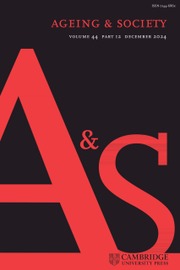No CrossRef data available.
Article contents
Ageing and late-life: an analysis of the barriers and resources experienced by colombian trans women
Published online by Cambridge University Press: 24 October 2025
Abstract
Trans people are among the most marginalized and stigmatized groups globally, facing high risks of discrimination, violence and abuse. In Colombia, older adults experience significant vulnerabilities and poverty, which are exacerbated for those with diverse gender identities, a population that remains invisible in this country. The existing literature on the ageing experiences of trans individuals, particularly in Latin America, is scarce, yet trans individuals in this region face widespread violence and discrimination. This article addresses this knowledge gap by exploring the ageing challenges encountered by Colombian trans women, through a qualitative study involving 23 trans women aged 50–67 living in Bogotá. It finds that older trans women face barriers throughout their lives, including stigma, gender-based violence, stigmatizing policies and political erasure. While some barriers persist for their lifecourse, others emerge in later life. A few resources are available at the structural, societal and individual levels to help trans women in Columbia cope with the ageing process. This article contributes to the limited knowledge of ageing in trans populations in the Global South. It shows how legal and social frameworks are pivotal in shaping ageing experiences that are unique to Colombia in ways not thoroughly explored in the Global North. It underscores the need for inclusive policies and practices that address the specific challenges of trans older adults. By adding to the social gerontological scholarship, this article will help inform debates and guide future research and policy development.
Information
- Type
- Article
- Information
- Copyright
- © The Author(s), 2025. Published by Cambridge University Press.

